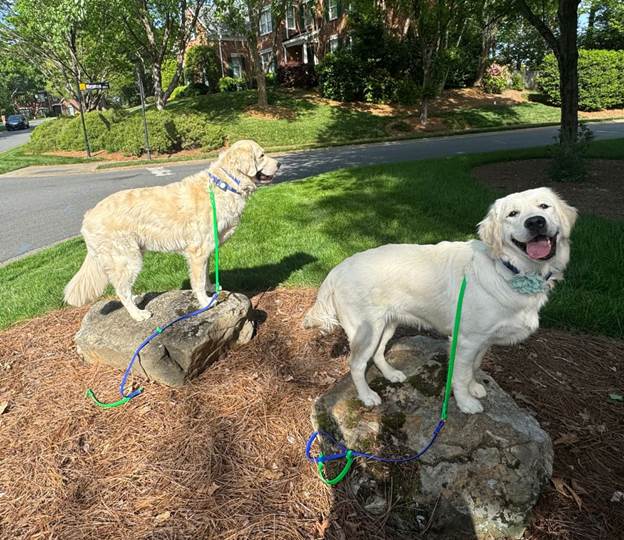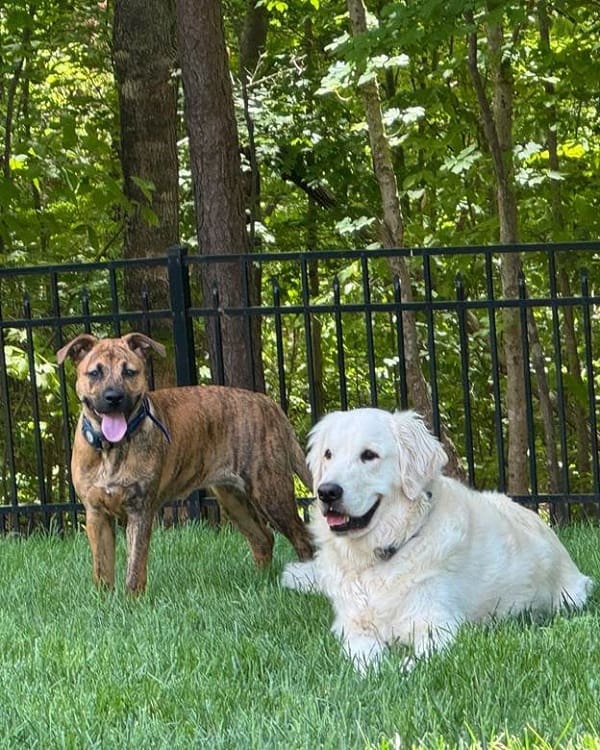A comprehensive guide on understanding canine communication signals to ensure safe and positive social experiences
In this guide, we’ll explore how to interpret subtle cues that indicate stress, fear, or aggression, focusing on three essential areas: Recognizing Calming Signals, Differentiating Play Bows from Aggressive Stances, and Understanding Tail Wags in Context.
Table of Content
Why Reading Body Language Matters
- By learning to interpret these signals, you can:
- Recognize early signs of stress or conflict and intervene before escalation.
- Encourage your dog to feel safe and understood during social situations.
- Strengthen your bond by responding to emotions instead of just behaviors.
In the Charlotte, NC area—where dogs often interact in parks, trails, and pet-friendly businesses—this skill is vital for maintaining harmony and safety.
1. Recognizing Calming Signals
Common Calming Signals
- Lip or Nose Licking: A quick lick when no food is present often indicates mild stress or unease.
- Yawning: A classic sign of tension or an attempt to calm themselves or others.
- Turning the Head Away: Avoiding direct eye contact to show peaceful intent.
- Freezing or Moving Slowly: Indicates uncertainty or a desire to de-escalate.
- Sniffing the Ground or Curved Approach: A polite, indirect way to approach another dog or person.
Why They Matter
How to Respond
- Slow Down: Give your dog space and time to adjust.
- Avoid Forcing Interaction: Allow them to retreat if needed.
- Reinforce Calm Behavior: Praise or treat relaxed postures.
Practice Awareness: In Charlotte’s dog-friendly spots, these moments are opportunities to strengthen your communication and deepen mutual trust.
2. Differentiating Play Bows from Aggressive Stances
What Is a Play Bow?
Signs of an Aggressive or Tense Stance
- Rigid Posture: Stiff body, legs locked, or weight shifted forward.
- Hard Eyes: Intense, fixed stare with no blinking.
- Raised Hackles: Hair along the back standing up.
- Stiff Tail: Held high, wagging in short, tight movements.
- Forward or Pinned Ears: Sign of alertness or confrontation.
How to Tell the Difference
| Playful Dog | Tense/Aggressive Dog |
|---|---|
| Loose, bouncy movements | Stiff, deliberate posture |
| Relaxed face, open mouth | Tight jaw, closed mouth |
| Takes turns during play | One-sided chasing or pinning |
| Soft, sweeping tail wag | High, rigid, or slow wag |
Why It Matters
3. Understanding Tail Wags in Context
What Different Tail Wags Mean
- High and Stiff Tail: Indicates alertness, dominance, or potential challenge.
- Neutral Tail with Loose Wag: Friendly, relaxed, and comfortable.
- Low or Tucked Tail: Fear, submission, or anxiety.
- Fast, Tight Wag: High arousal—could be excitement or agitation.
- Slow Wag with Minimal Movement: Caution, uncertainty, or suspicion.
Research suggests even wag direction matters: dogs tend to wag more to the right when feeling positive, and more to the left when feeling anxious.
Applying This Knowledge
Owner Tips
- Assess the whole body—not just the tail.
- Intervene calmly if tension rises.
- Reward relaxed posture and loose wags to reinforce calm energy.
4. Putting It All Together
You’re at a Charlotte dog park. Your dog approaches another dog with a loose body and mid-level wag. The other dog responds with a play bow. Great! The dogs begin playing. A few minutes later, your dog’s tail stiffens and body leans forward. You notice the other dog turning away and licking its lips—a calming signal. Time to intervene: calmly call your dog away, reward compliance, and give them both a break.
By observing and responding early, you prevent a potential scuffle and reinforce your role as your dog’s trusted guide.
5. Why the Relationship-Based Approach Works
When you learn your dog’s language, you can:
- Anticipate behavioral issues before they escalate.
- Build confidence in both you and your dog.
- Foster mutual respect and a lifelong bond.
Our in-home private sessions, Jumpstart + Board and Train, and Auto-Pilot VIP Programs all integrate these communication skills, ensuring your dog’s training aligns with their natural instincts and emotions.
Final Thoughts
In a dog-loving community like Charlotte, North Carolina, these skills not only enhance your bond with your dog but also contribute to a more harmonious dog-friendly culture overall.
If you want to deepen your understanding or see how our personalized programs can help, reach out to Dog Owners Academy for a free in-home consultation today.
Together, we can build a world where dogs and their owners truly understand each other.
Opening Hours
M-Sa: 10am - 7pm
Address
1111 Central Ave., Charlotte, NC 28204
Phone
844 864 3647




